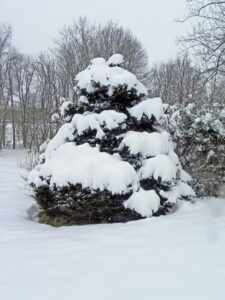The Depth of Winter
“To appreciate the beauty of a snowflake it is necessary to stand out in the cold.” Aristotle
 The long, cold days of winter are upon us. We are blanketed with about a foot of snow that is in no hurry to disappear. Another winter storm or two is racing across the country as I write this, with more snow and ice predicted. Our usual scenario in winter is one where we get several inches of nice new snow; it then warms just enough to turn it into soft, almost slush, and then it freezes and stays frozen for days, keeping a treacherous layer of ice for us to navigate. This time though, mother nature has seen fit to blanket us in soft powdery snow and leave it to sit peacefully atop everything. That didn’t last either. Yesterday, as the temp hovered near freezing, a wet, soupy fog engulfed us and now the snow has a distinct crust on the top. The dogs love to bound through the snow. If we get much more though, we may not be able to find them. It’s currently up to their shoulders.
The long, cold days of winter are upon us. We are blanketed with about a foot of snow that is in no hurry to disappear. Another winter storm or two is racing across the country as I write this, with more snow and ice predicted. Our usual scenario in winter is one where we get several inches of nice new snow; it then warms just enough to turn it into soft, almost slush, and then it freezes and stays frozen for days, keeping a treacherous layer of ice for us to navigate. This time though, mother nature has seen fit to blanket us in soft powdery snow and leave it to sit peacefully atop everything. That didn’t last either. Yesterday, as the temp hovered near freezing, a wet, soupy fog engulfed us and now the snow has a distinct crust on the top. The dogs love to bound through the snow. If we get much more though, we may not be able to find them. It’s currently up to their shoulders.

Winters here are much harder on our bees than they used to be. With so many maladies affecting honey bees over the last couple of decades, the bees aren’t as hardy as they used to be. While the depth of winter is when many bee colonies will lose the strength in numbers to survive, it is early spring when we often seem to lose a colony. On a warm sunny day in early spring, we may see bees flying and coming and going from the hive, but this can give you a false sense of security. We might breathe a sigh of relief, thinking the colony has made it through the winter, only to see them dwindle. If their numbers have declined so over the winter, and with their stores diminished, even when given supplemental feeding at this point, they may not survive. The longer the winter drags on, the less likely the colonies will survive. But, bees are surprisingly resilient and have been around far longer than humans, so we can only hope for the best. In what seems an amazing feat of nature, the cluster of bees in those bee boxes in frigid winter temperature regulates the temperature at the core of the cluster to 95 degrees by vibrating their wings. The outer layer of bees is at about 48 degrees, and they will eventually rotate into the center to get warm.

 On a sunny winter day just a few weeks ago, even though it was frigid out, bluebirds called and sat atop the bluebird boxes. The sun has a way of making one feel good and believing that spring is just around the corner, even though it may still be a ways off.
On a sunny winter day just a few weeks ago, even though it was frigid out, bluebirds called and sat atop the bluebird boxes. The sun has a way of making one feel good and believing that spring is just around the corner, even though it may still be a ways off.
We tend to get a lot of wind around here, so it’s quite unusual to see the snow remain stacked high. Usually, a blustery wind makes quick work of any snow coating the tree limbs or evergreen branches. The deep snow on this blue spruce has been sitting there for days now.
With the amount of snow piled around the high-tunnel, it is a bit hard to think about gardening and starting seeds, but it will soon be time to do just that. It is surprising how hardy some plants, with a bit of protection, will continue to grow. We had fresh greens in our high-tunnel up into December, and it will soon be time to replant in there for early spring greens. It doesn’t take much sun to warm the interior to a toasty 80 degrees.

So, while we are still in the depth of winter, the days are becoming longer; before too long, the snow and ice will melt, the sun will shine, and the sap will begin to flow. But, until then, step outside into the cold and appreciate the beauty of a snowflake.

Good thoughts. To me, snow seems as magical as it always did.